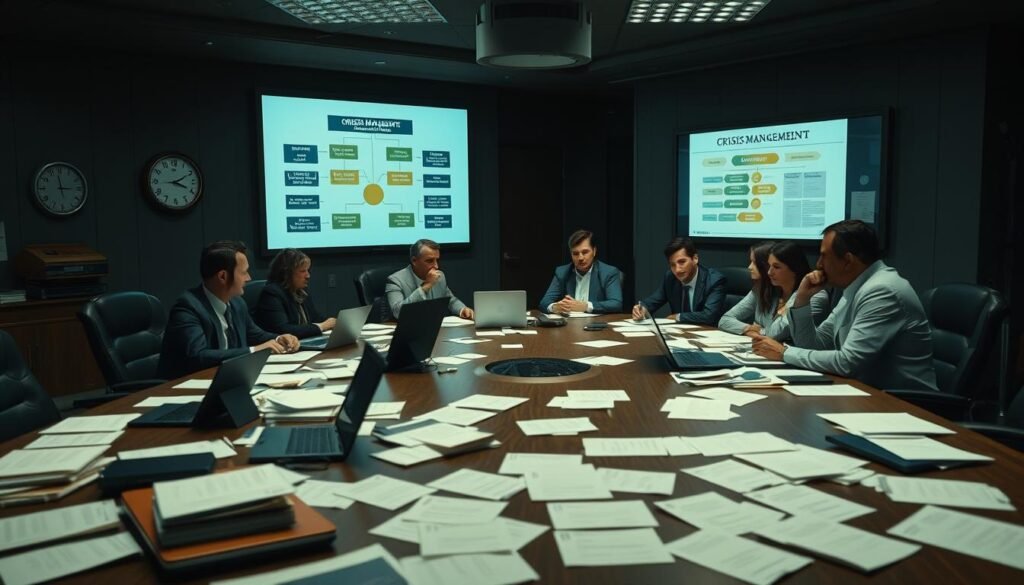In today’s fast-paced business world, companies often face tough scrutiny. This can happen for many reasons, like dealing with bad products or management issues. Corporate scandals, legal battles, and unexpected problems can really hurt a company’s image. But, there’s a powerful tool you can use: the press release.
Press releases are key for brands in tough spots. They let you share your side of the story, be open, and win back trust. Whether it’s a product recall, data breach, or PR issue, good crisis press releases are quick, clear, and honest. They tackle the problem fast, even if you don’t have all the facts.
When it comes to crisis management, timing is everything. A well-made crisis press release can change how people see your brand. It can also lessen the harm to your reputation.
Key Takeaways
- Press releases are a crucial tool for crisis management, enabling brands to control the narrative and communicate transparently.
- Effective crisis press releases must be proactive, swift, and transparent, addressing the issue promptly.
- Timing is essential in crisis management, and press releases can significantly influence the outcome.
- Companies often face scrutiny in various scenarios, including defective products, management failures, corporate scandals, and legal trials.
- Crafting a well-designed crisis press release can help mitigate the potential damage to your brand’s reputation.
Understanding Crisis Communication Press Releases
In a corporate crisis, how you talk to the media is key. Crisis communication press releases are a vital tool. They are different from regular press releases because they focus on quick action, being open, and sharing all the facts.
These releases explain the crisis, its effects, and any problems it might cause. They also show how the company plans to fix the issue. This helps keep trust with stakeholders during a corporate crisis or public relations crisis.
Creating a good crisis response press release needs careful thought and planning. It should have a clear headline, a short summary of the crisis, and how the company is responding. It should also include a summary and contact info. The sooner it’s released, the better the company can handle the crisis response.
| Statistic | Value |
|---|---|
| Percentage of organizations that use crisis communication press releases to communicate with their audience | 100% |
| Average time it takes for an organization to craft a response after a crisis occurs | 72 hours |
| Percentage of organizations that have pre-made templates for holding statements ready in advance | 75% |
Understanding crisis communication press releases helps organizations handle media relations and corporate crises better. This keeps stakeholder trust and reduces damage to the company’s reputation.

“In a crisis, the first response you need to focus on is communication, not just clean-up. You want to get in front of it as quickly as possible to manage the narrative and control the story.”
Essential Components of an Effective Press Release
A well-crafted crisis press release is key for reputation management. These communications are crucial for any damage control strategy. To make your press release stand out, include several important elements.
Your press release should start with a catchy headline. It should be short, clear, and grab attention. A subheader can then summarize the main points, giving a quick overview.
The dateline is also vital. It shows when and where the release was sent. This makes the information timely and relevant.
The body of the press release should explain the crisis and your actions. Be open and honest. Take responsibility and make promises you can keep to keep trust.
- Include quotes from key figures to add a personal touch.
- Make sure to answer the “5Ws”: Who, What, When, Where, and Why.
- End with your company logo and media contact info for easy access.
Use AI tools to help write and edit your press release. Knowing how to create an effective press release helps manage your brand’s reputation. It also helps you handle crises with confidence.
| Key Element | Purpose | Best Practices |
|---|---|---|
| Headline | Captures the essence of the crisis | Keep it concise, compelling, and under 100 characters |
| Subheader | Summarizes key details | Provide a snapshot of the situation in a single sentence |
| Dateline | Establishes timeliness and relevance | Include the date and location of the release |
| Body | Explains the crisis and actions taken | Maintain transparency, take responsibility, and make realistic promises |
| Quotes | Adds a personal touch | Include quotes from key figures within the organization |
| Call to Action | Encourages further engagement | Provide clear media contact information |

“By mastering the essential components of an effective press release, you’ll be well on your way to managing your brand’s reputation and navigating any crisis with confidence.”
Managing Brand Reputation Through Press Releases
In times of crisis, press releases are key to rebuilding reputation and winning back trust. They should show your company’s values, thank supporters, and align with stakeholders’ interests. Business transparency is crucial here, as it greatly affects how people see and buy from your brand.
Research shows 87% of consumers are more likely to buy from trusted brands. By making press releases that reflect your values and crisis response, you build a strong base. With 82% of consumers valuing companies with clear values, it’s vital to balance social media and traditional media while keeping your message consistent.
Using press releases to show your commitment to stakeholders, express empathy, and outline your actions is key. This approach not only rebuilds trust but also makes your brand a leader in ethical crisis management.
“Effective press releases during a crisis can be the difference between weathering the storm and losing public confidence in your brand.”
By using press releases wisely, you can get through a crisis stronger. Your brand will gain confidence and loyalty from customers and stakeholders.
Implementing Press Release Crisis Response Strategy
When a crisis hits, a well-made press release can help a lot. It’s key for public image protection, crisis recovery, and fixing brand trust. The goal is to show corporate accountability. Here’s how to do it right:
- Admit the problem quickly and own up to it. Keep everyone updated on what’s being done to fix it.
- Share what you’ve learned from the crisis. Talk about changes made and new plans that help everyone.
- Focus on what you’ll do next to improve. Make sure what you say inside the company matches what you say outside. This keeps everyone on the same page.
- Be honest, caring, and real in what you say. Stay away from sounding defensive or too proud.
Studies say you should act fast, usually within 24 hours. Being open about what’s happening helps build trust. Press releases should have solid facts and figures to show you’re telling the truth.
| Key Considerations | Benefits |
|---|---|
| Well-coordinated crisis response team | Ensures speed and precision in response |
| Timely updates in press releases | Prevents media from seeking information from unauthorized sources |
| Tailoring press releases to address stakeholders’ concerns | Essential for effective crisis communication |
| Consistency and coordination of communication across platforms | Crucial during a crisis |
By using this crisis plan, you can keep your image safe, get through the crisis, and regain brand trust. Do it with clear and honest communication.
Conclusion
Press releases are key tools for managing crises. They let you shape the story, share facts, and show you’re serious about fixing problems. These messages help you admit mistakes, give updates, highlight your values, and learn from them. This way, you can start to rebuild your reputation.
To make your press releases count in crises, they must be timely, open, and true to your company’s values. Using press releases well is vital for keeping trust with your stakeholders. It helps you manage how people see you, talk clearly, and come out stronger after tough times.
Press releases are vital crisis management tools for handling your brand reputation and sharing important messages in hard times. Using this PR strategy wisely lets you take charge, be clear, and show your dedication to your stakeholders. This strengthens your market position.


